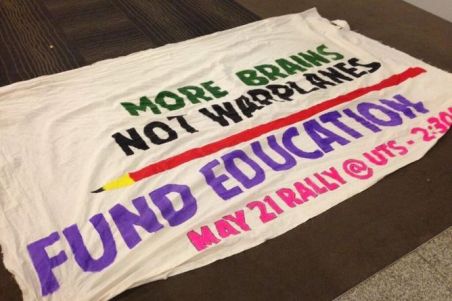Dear friends,
I am a little late in posting this up. Please find below my article published by Red Flag which looks at the underlying structural cause of the Sewol ferry tragedy in South Korea. On April 16, the Sewol ferry was travelling between Incheon and Jeju Island when it capsized, resulting in the death of more than 300 of the 476 passengers on board. Nearly all those who died were teenagers – students from the one high school , who were in the same grade. They were participating in a school field trip at the time. Amongst the other casualties were teachers from the school, at least one crew member and several other passengers.
The tragedy has rocked South Korea to its foundations and has been terribly heartbreaking and enormously sad. In the past few weeks, there has been increasing outrage at the Park Geun-hye government due to the bungled rescue operation, the lack of safety protocols in place nationally to deal with such disasters, as well as at crony capitalism and government- industry corruption which lie at the core of this tragedy. Many of the families of the students have begun to stage protests and there has been mass protests in Seoul and elsewhere. Most recently more than 2000 students held a candle light vigil and protest in remembrance of their friends and on the weekend more than 30,000 people attended the candlelight vigil and protest in Seoul. In the last few days more than 6,000 school teachers also took to the streets to protest against the Park Geun-hye government as a result of the Sewol tragedy and more than 15,000 teachers have signed a statement criticising the government.
***

The tragic death of more than 300 South Korean students last month has revealed starkly the menace of neoliberal economics. The students were aboard the Sewol ferry, on a school trip, when it capsized with 476 passengers and crew on board.
Only 170 people managed to escape. Hopes for the remaining 306 soon dissipated in the wake of a bungled rescue attempt, which was too slow and hampered by bad weather. While the majority of bodies have been recovered, approximately 30 are still missing.
Nearly all the dead and missing are students from Danwon high school. The tragedy has sent shock waves throughout South Korea. Since 27 April, 1.5 million people have visited memorial altars around the country.
While many Western journalists have sought to promote racist Orientalist stereotyping blaming the tragedy on South Korea’s “Confucian society”, the root of the tragedy lies in crony capitalism.
Almost two decades of neoliberal policies have resulted in a sharp increase in irregular, temporary employment contracts with no job security and salaries that are, on average, 35 percent less than those of regular workers. Today, irregular workers make up 45 percent of South Korea’s workforce. The result is poor working conditions and the downgrading of safety awareness and practice.
In the case of the Sewol, 19 of the 33 crew members were irregular workers – including the captain.
The deregulation of South Korea’s shipping industry under the right wing Lee Myung-bak government (2008-2013) also resulted in a rise in unsafe practices. Deregulation extended ferry service periods from 20 to 30 years, allowing older ships such as the Sewol to continue operating.
A 29 April editorial in the Korean Herald noted the granting of reciprocal favours and a “revolving door between the government and shipping sector”. Industry jobs were granted to “former government officials, mostly from ministries that supervise and regulate shipping companies”.
In the wake of the tragedy, investigators have identified a collusive and corrupt relationship between government officials and the shipping industry, centring on the government-run Korean Register of Shipping, which is responsible for testing and certifying ships and carrying out routine shipment and safety inspections.
The immediate cause of the Sewol’s sinking was overloading and an unsecured cargo. The vessel was carrying up to three times its official cargo limit. According to investigators, since March 2013 the Sewol had carried excess cargo on its Incheon-Jeju route 139 times, resulting in almost US$3 million in profit for the owner, Cheonghaejin Marine Company.
Investigations also revealed unsafe practices on the company’s other ferries, including unsecured cargos and a lack of working life rafts. On 8 May, Cheonghaejin Marine CEO Kim Han-sik was arrested and charged with causing death by negligence.
Public anger over the tragedy, bungled rescue operation and government-industry corruption has continued to rise. On 28 April, Prime Minister Chung Hong-won announced his resignation. Bereaved families have staged several marches on the Blue House (the executive office and residence of the president) and on 10 May, thousands of students held a candlelight vigil and protest.
On May Day, tens of thousands of Korean workers also took to the streets to express their “sorrow and rage” at the disaster and at the neoliberal policies that caused it.
The Korean Confederation of Trade Unions in its May Day statement said: “Safety experts are now pointing to excessive deregulations, privatisation of public transport and emergency services, the use of precarious work arrangements and the corrupt appointment of officials in oversight agencies as causes of the Sewol tragedy.”
The union stated the root cause of the ferry tragedy was “capitalist greed and government support for it”.









